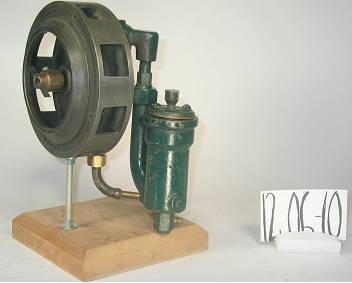Pressure Atomizing Oil Burner Equipment and Systems – Oil Pumps
A compact, functionally integrated fuel pump assembly for gun type, low pressure atomizing oil burner, with flange motor mount, air intake housing, fuel pump, and pressure gauge 0 to 20 psi., all over coated in classic black-green gloss enamel of the period; equipped with drive coupling, pressure regulating valve, fitments, and oil filter all executed in solid brass/bronze, all targeted on the affluent, discerning, life style seeking householder, Fess, Model J18, Circa 1930. [see also 12.06-11]
Technical Significance:
By the early 1930’s the Canadian oil heating industry was progressing well beyond simple, gravity feed, vaporizing oil-heating equipment [see Group 11,05 artifacts]. Having developed mechanical, low pressure atomizing machinery [see ID# 12.06-9], it was ready to move on to more efficient, cleaner and more reliable atomizing methods, to be found in the pressure-atomizing “gun” burner technology of the period.
This historic artifact models well the sophisticated engineering and design achievements of the period, in compact, functionally integrated fuel oil pump assemblies for low pressure atomizing oil burners.
Modelled here is the best of the offerings of the industry to Canadian home owners of the period – at least to those that could afford the best and the latest is advanced automatic home heating technology in the early 1930 – in the midst of national economic depression.
A superb example of what was now possible, given the advances in oil atomizing technology, metallurgy, manufacturing and fabrication methods of the day.
Exemplified, too, is a new era of industrial craftsmanship with an eye for a new of eye-catching and pleasing industrial styling.
Seen here is a new generation of mechanical equipment, targeted on the hearts and minds of the Canadian homeowner, equipment which was starting to loose the crude industrial machinery look, and develop a new aesthetic, one distancing its self from the factory floor look of a few years earlier [see 12.06-9].
What had been acquired by the industry was a new sense of how to smoothly integrate and articulate mechanisms traditionally of widely different functions [oil pumps, motors, fans and pressure valves] into a single functioning whole. A new kind of sophisticated entity had been created, one made all the more appealing to the early 20th century discriminating homeowner of good taste with the addition of polished brass fitments. See Note #2
The new gun style burner consisted of a direct drive, flange mounted motor, a Sirocco type high pressure fan to deliver primary air for combustion, a compact positive displacement, gear pump, an oil atomizing nozzle, high potential electrical transformer, and ignition electrodes.
Industrial Significance:
Fess Oil Burners of Canada [later the John Wood Company, Toronto] became a major player in the development of the automatic oil heating industry, starting in the late 1920’s
Capitalizing on the sales potential of the new more compact and reliable “gun” type technology, the Fess J series of automatic oil burners would be representative of a new generation of highly innovative equipment, taking advantage of the newly emerging Canadian market in the early 1930’s.
Its Model J series of gun type, pressure atomizing burners, in their characteristic black-green, would be a familiar site in the basements of the well-to-do across much of central Canada in the 30’s.
The industry was moving to more compact, functionally integrated, unitary equipment configurations, away from the industrial machinery look. With the advent of the high pressure gun burner, the basic oil burner configuration had been established which, with many modifications and enhancements, would largely characterize the field through to the end of the 20th century.


